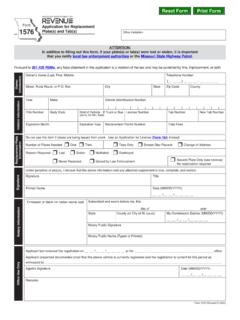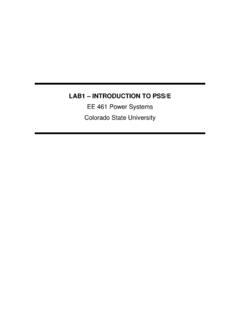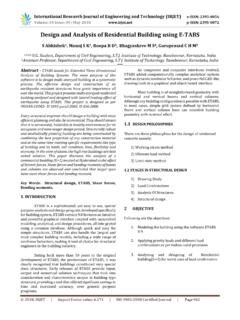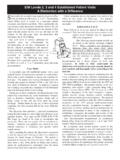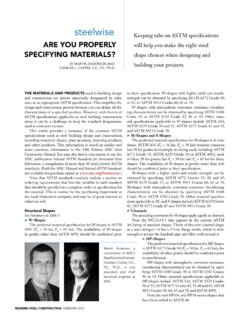Transcription of DEPARTMENT OF THE AIR FORCE - AF
1 OFFICE OF THE ASSISTANT SECRETARY DEPARTMENT OF THE AIR FORCE WASHINGTON DC 3 May 2021 MEMORANDUM FOR THE ACQUISITION ENTERPRISE FROM: SAF/AQ SUBJECT: Guidance for e-Program Designations Implementing the DEPARTMENT of the Air FORCE s transition to Digital Acquisition involves artful execution of the Digital Building Code. The tabs in this memorandum provide the first iteration of the DEPARTMENT s Digital Building Code, and also introduce the initial version of the e-Program Criteria Scorecard used by the Service Acquisition Executive (SAE) to assess a program for an e-Program designation. The Digital Building Code is intended to be a living set of thoughtful standards, regularly updated and maintained as the DEPARTMENT learns during our digital transformation and as technologies continue to evolve. To this end, the Digital Building Code and e-Program Criteria Scorecard contained in this memorandum are the DEPARTMENT s initial versions.
2 Subsequent updates will supersede the versions contained here. These current versions, and future updates, will be posted to the SAF/AQ website at Once posted to the website, the update will become the authoritative source of the guidelines and criteria. Scaling Digital Acquisition tools, techniques, and practices requires a shared lexicon and understanding of terms. To help clarify past SAF/AQ direction, and provide a consistent vocabulary across the acquisition enterprise, use the following definitions to characterize the program s acquisition approach: 1. Conventional Programs: Acquisition programs employing a traditional strategy using existing tools and processes to field and deliver warfighting capability. This is the default rating for a program until the SAE specifically designates a program as an e-Program. 2.
3 E-Programs: Acquisition programs employing the digital trinity ( , digital engineering, agile software, and open systems architecture) of Digital Acquisition to replace, automate, or truncate real-world activities based on authoritative virtualization or automation in the digital world. The attached tabs provide detailed information for how the SAE will assess and identify activities as e-Programs. The SAE may delegate e-Program designations as required. 3. e-Series Programs: An e-Program with a strategic pre-planned replacement schedule ( , Series) based on a cadence driven by economic Total Cost of Ownership and life span to drive speed and agility to stay ahead of the threat by delivering at the pace of technology maturation. These definitions provide the flexibility to characterize efforts at the Mission Design Series level, such as Ground Based Strategic Deterrent (an e-Program born digital) and Next Generation Air Dominance (the first e-Series Program), as well as subsystem level programs for legacy platforms that meet the criteria for an e-Program ( , the A-10 Rewing Program, the B-52 Commercial Engine Replacement Program).
4 A shared understanding of what constitutes an e-Program or an e-Series Program implemented with an interative approach and a clear focus on learning will help accelerate the speed of Digital Acquisition integration into our existing programs and posture us for future successes. 2 Digital Acquisition holds the key to unleashing the speed and agility we need to field capability at the tempo required to win in a future conflict with a peer competitor. The attached tabs give you an initial point of departure for executing programs to the Digital Building Code. I look forward to seeing your e-Program designation requests in the near future as we implement Digital Acquisition together! Darlene J. Costello Acting Assistant Secretary of the Air FORCE (Acquisition, Technology & Logistics) 3 Table of Contents: Tab 1: Digital Building Code for Digital Engineering Tab 2: Digital Building Code for Agile Software Tab 3: Digital Building Code for Open Systems Architecture Tab 4: e-Program Criteria Scorecard 4 TAB 1: DIGITAL BUILDING CODE FOR DIGITAL ENGINEERING As discussed in Bending the Spoon: Guidebook for Digital Engineering and e-Series, the key to employing Digital Engineering is achieving a measure of authoritative virtualization that replaces, automates, or truncates formerly real-world activities.
5 This is how you realize game-changing agility that Digital Acquisition can deliver for your program and our warfigthers. And it is also how you will realize the return on investment (ROI) for your digital transformation efforts. The Digital Building Code for digital engineering which follows provides fulsome guidance to help you bend the spoon. The following guidance is provided to assist PEOs/PMs to determine and implement Digital Engineering: 1. Develop digital models of systems Build and maintain model-based representations of systems in commercial-off-the-shelf (COTS) architecture tools using Systems Modeling Language (SysML), or equivalent modeling language. This enables the effective exchange of information including requirements, system functions, and process flows between all organizations involved in the development process. Reference an established style guide to build and maintain the models.
6 Consult the Air FORCE Digital Guide ( ) for the latest guidance on the most suitable style guide. Encapsulate all necessary elements in models with appropriate tags to facilitate tracing to requirements and certifications. Clearly link requirements to planned verification activities ( , technical reviews, certification, testing plans, procedures). Construct models to enable the following to be traced from the requirements: analysis of requirements, system architecture design, allocations, interfaces, certifications, and functional thread analysis. Include capabilities to predict operational performance and quantify uncertainty in models of a system or subsystem in a simulated, representative environment. 2. Develop a digital twin and digital thread Establish and manage a digital thread that links models and digital artifacts and creates an authoritative source of truth.
7 A program or a platform may be an integrator of multiple digital threads comprising the system. The intent is to create a comprehensive system digital thread. Update digital artifacts throughout the system lifecycle to maintain a digital twin of the system. Construct digital threads using a data architecture that defines the data, schemas, integration, transformations, storage, and workflows required to design and sustain the system. The data architecture should also define naming conventions, data types/formats, integrity, archival/retention, security, flows, pipelines, linkage with associated metadata, and transformations. 3. Implement an integrated digital environment Use an integrated digital environment (IDE). An IDE is a compilation of data, models, and tools for collaboration, analysis, and visualization across functional domains.
8 An IDE includes the methodology and specification for data, models, and tools arrangement with processes and procedures to exploit informational results. An ideal IDE leverages the following: 5 Development Platform: CloudONE, PlatformONE, and DataONE. Architectural Modeling: COTS software such as CAMEO Systems Modeler, Sparx Enterprise Architect, or IBM Rhapsody. Product Lifecycle Management (PLM): Siemens Teamcenter or approved alternative. For additional information: Operational Analysis: AFSIM or other M&S environments. Requirements Management: COTS software such as DOORS or CAMEO Systems Modeler. Determine and implement an IDE strategy that specifies preferred digital tools, considers tools accessibility and security considerations, and outlines the impact this strategy will have on internal and industry collaborations ( , tool integration, data interoperability).
9 A cost benefit analysis should assess whether to acquire and deploy tools, use DoD High Performance Computing Modernization Program (HPCMP) resources, or negotiate the use of tools by industry performers. Tips for initial implementation of an IDE can be found at the Air FORCE Digital Guide: 4. Employ a tailored digital strategy for contracting with industry Because digital transformation is in its early stages, contracting guidance is rapidly evolving. For the latest recommendations and templates, please see the Air FORCE Digital Guide contracting section: Here practitioners can access information on Key Digital Features that should be considered during contracting actions. In addition, programs can access example contract language from other acquisitions. Additional contracting Tactics, Techniques, and Procedures (TTPs) on this and related topics will be added over time and available online through Air FORCE Contracting Central.
10 5. Ensure organizational readiness for Digital Engineering To ensure a central point of contact for tools and infrastructure needs, enable consistent implementation and coordination, and ensure sharing of lessons learned and collaboration, programs may designate the Chief Engineer, or an alternate, as the DE focal point within their organization. The DE focal point is responsible for specifying general digital engineering training, courses, and certifications for the program to ensuring an organizational minimum working knowledge of digital engineering, regardless of function. Examples of available workforce training for digital tools and related infrastructure, include: SysML based tools (or their equivalent). Also consider other related training, such as UPDM, UAFP, UML, BPMN, and XML. CloudONE and PlatformONE services.



